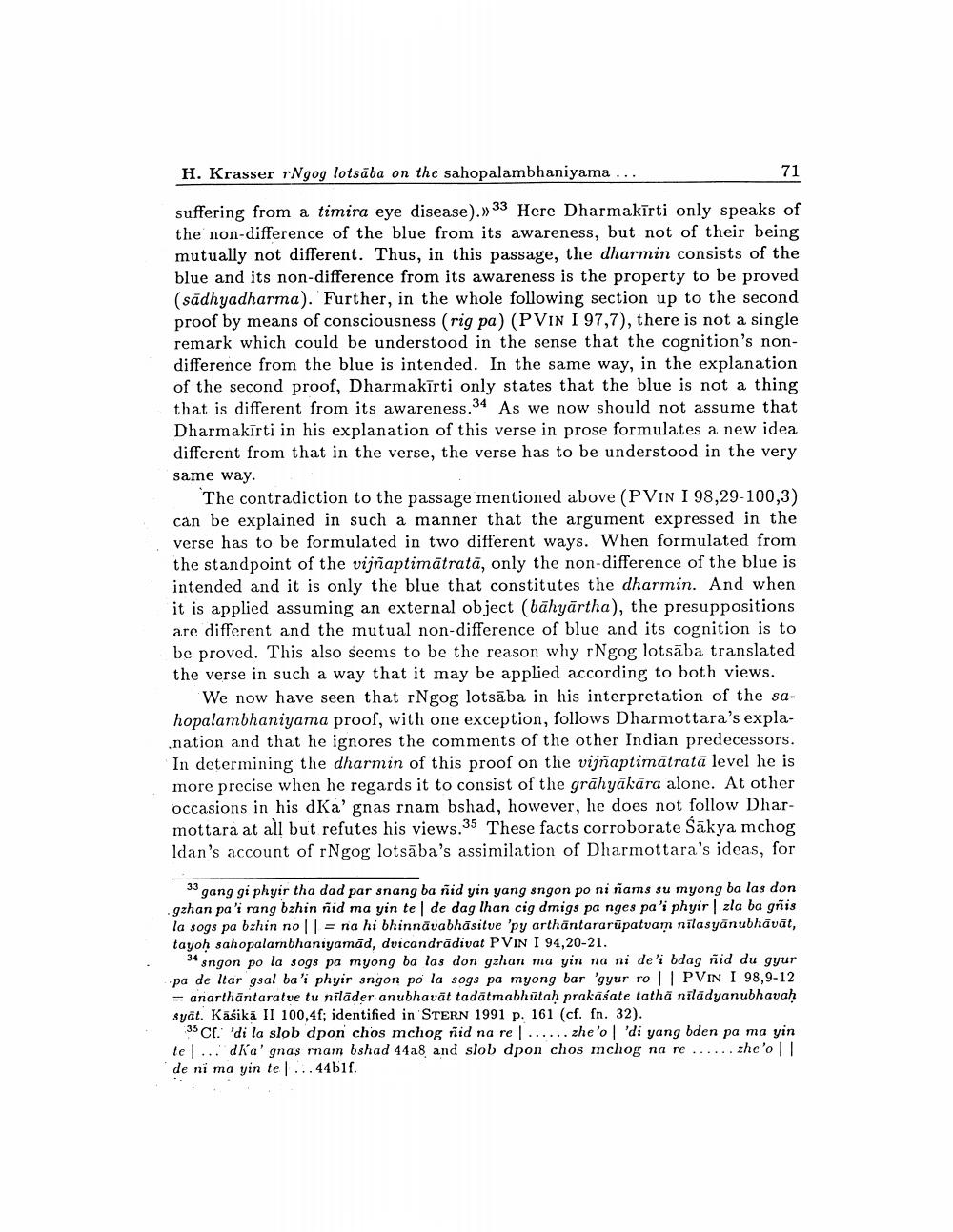Book Title: Rngog Lotsaba On Sahopalambhaniyama Proof In Dharmakirtis Pramanaviniscaya Author(s): Helmut Krasser Publisher: Helmut Krasser View full book textPage 9
________________ H. Krasser rNgog lotsāba on the sahopalambhaniyama... suffering from a timira eye disease).» 33 Here Dharmakīrti only speaks of the non-difference of the blue from its awareness, but not of their being mutually not different. Thus, in this passage, the dharmin consists of the blue and its non-difference from its awareness is the property to be proved (sādhyadharma). Further, in the whole following section up to the second proof by means of consciousness (rig pa) (PVIN I 97,7), there is not a single remark which could be understood in the sense that the cognition's nondifference from the blue is intended. In the same way, in the explanation of the second proof, Dharmakīrti only states that the blue is not a thing that is different from its awareness. 34 As we now should not assume that Dharmakīrti in his explanation of this verse in prose formulates a new idea different from that in the verse, the verse has to be understood in the very same way. The contradiction to the passage mentioned above (PVIN I 98,29-100,3) can be explained in such a manner that the argument expressed in the verse has to be formulated in two different ways. When formulated from the standpoint of the vijñaptimātratā, only the non-difference of the blue is intended and it is only the blue that constitutes the dharmin. And when it is applied assuming an external object (bāhyārtha), the presuppositions are different and the mutual non-difference of blue and its cognition is to be proved. This also seems to be the reason why rNgog lotsāba translated the verse in such a way that it may be applied according to both views. We now have seen that rNgog lotsāba in his interpretation of the sahopalambhaniyama proof, with one exception, follows Dharmottara's expla.nation and that he ignores the comments of the other Indian predecessors. In determining the dharmin of this proof on the vijñaptimātrata level he is more precise when he regards it to consist of the grāhyākāra alone. At other occasions in his dKa' gnas rnam bshad, however, he does not follow Dharmottara at all but refutes his views.35 These facts corroborate Sākya mchog ldan's account of rNgog lotsāba's assimilation of Dharmottara's ideas, for 3 gang gi phyir tha dad par snang ba nid yin yang sngon po ni nams su myong ba las don .gzhan pa'i rang bzhin nid ma yin te de dag lhan cig dmigs pa nges pa'i phyir | zla ba gñis la sogs pa bzhin noll = na hi bhinnāvabhāsitve 'py arthāntararūpatvam nilasyänubhāvät, tayoh sahopalambhaniyamād, duicandradivat PVIN I 94,20-21. sngon po la sogs pa myong ba las don gzhan ma yin na ni de'i bdag rid du gyur pa de Itar gsal ba'i phyir sngon po la sogs pa myong bar 'gyur ro || PVIN I 98,9-12 = anarthäntaratve tu niläder anubhavāt tadātmabhūtah prakāśate tathä nilädyanubhavah syat. Kašika II 100,4f; identified in STERN 1991 p. 161 (cf. fn. 32). 35 Cf. 'di la slob dpon chos mchog nid na re ...... zhe 'ol 'di yang bden pa ma yin tel... dk'a' gnas rnam bshad 44a8 and slob dpon chos mchog na re ......zhe'oll de ni ma yin te...44b1f.Page Navigation
1 ... 7 8 9 10 11 12 13 14 15 16 17 18 19 20 21 22 23 24 25 26
